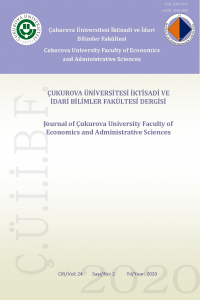Amerikan 10 Yıllık Tahvil Faiz Oranlarına Dayanılarak BİST 100 Endeks Tahmininde Ağaç Tabanlı Regresyon Modelleri Uygulaması
BİST 100 Endeksi, Tahvil Faizi, Rastgele Orman (RF) Modeli, Çok Değişkenli Uyarlanabilir Regresyon Eğrileri (MARS) Modeli.
Amerikan 10 Yıllık Tahvil Faiz Oranlarına Dayanılarak BİST 100 Endeks Tahmininde Ağaç Tabanlı Regresyon Modelleri Uygulaması
BIST 100 Index, Bond Rate, Random Forest (RF) Model, Multivariate Adaptive Regression Spline (MARS) Model.,
___
- Başakın, E. E., Özger, M., & Ünal, N. E. (2019). Gri tahmin yöntemi ile İstanbul su tüketiminin modellenmesi. Politeknik Dergisi, 22(3), 755-761.
- Bauder, R. A., & Khoshgoftaar, T. M. (2017, December). Medicare fraud detection using machine learning methods. In 2017 16th IEEE international conference on machine learning and applications (ICMLA) (pp. 858-865). IEEE.
- Breiman, L. (2001). Random Forests. Machine learning, 45(1), 5-32.
- Campbell, J. Y. (1987). Stock Returns and the Term Structure. Journal of Financial Economics, 18(2), 373-399.
- Cao, N., Galvani, V., & Gubellini, S. (2017). Firm-Specific Stock and Bond Predictability: New Evidence from Canada. International Review of Economics & Finance, 51, 174-192.
- Cihangir, Ç. K., & Tanrıöven, C. (2016). Abd Devlet Tahvili Faiz Oranlarındaki Değişimin Kurlara Etkisi; Kırılgan Paralar, Kırılgan Ekonomiler. İşletme Araştırmaları Dergisi, 8(4), 1-14.
- Demirkol, D., Kartal, E., Şeneler, Ç., & Gülseçen, S. (2019). Bir Öğrenci Bilgi Sisteminin Kullanılabilirliğinin Makine Öğrenmesi Teknikleriyle Tahmin Edilmesi. Veri Bilimi, 2(1), 10-18.
- Desai, V. S., & Bharati, R. (1998). The efficacy of Neural Networks in Predicting Returns on Stock and Bond Indices. Decision Sciences, 29(2), 405-423.
- Devpura, N., Narayan, P. K., & Sharma, S. S. (2021). Bond Return Predictability: Evidence from 25 OECD Countries. Journal of International Financial Markets, Institutions and Money, 101301.
- Duran, M., Özlü, P., & Ünalmis, D. (2010). TCMB Faiz Kararlarinin Hisse Senedi Piyasalari Üzerine Etkisi. Central Bank Review, 10(2), 23.
- Elton, E. J., Gruber, M. J., Agrawal, D., & Mann, C. (2001). Explaining the Rate Spread on Corporate Bonds. The Journal of Finance, 56(1), 247-277.
- Eyüboğlu, S., Eyüboğlu, K. (2018). Amerikan 10 Yıllık Tahvil Faizleri İle Gelişmekte Olan Ülke Borsaları Arasındaki İlişkinin Test Edilmesi. Yönetim Bilimleri Dergisi, 16(31), 443-459.
- Fama, E. and K. French, 1993, Common Risk Factors in the Returns on Stocks and Bonds, Journal of Financial Economics, 33, 3–56.
- Fang, L., Yu, H., & Huang, Y. (2018). The role of Investor Sentiment in the Long-Term Correlation Between US Stock and Bond Markets. International Review of Economics & Finance, 58, 127-139.
- Friedman, J. H., & Roosen, C. B. (1995). An Introduction to Multivariate Adaptive Regression Splines.
- Genuer, R., Poggi, J. M., Tuleau-Malot, C., & Villa-Vialaneix, N. (2017). Random Forests for Big Data. Big Data Research, 9, 28-46.
- Goh, A. T., Zhang, Y., Zhang, R., Zhang, W., & Xiao, Y. (2017). Evaluating Stability of Underground Entry-Type Excavations Using Multivariate Adaptive Regression Splines and Logistic Regression. Tunnelling and Underground Space Technology, 70, 148-154.
- Green, C. J. (1991). ‘Quick’Methods of Estimating The Price Of Government Bonds. Oxford Bulletin of Economics and Statistics, 53(3), 295-311.
- He, J., Harris, J. R., Sawada, M., & Behnia, P. (2015). A comparison of Classification Algorithms Using Landsat-7 and Landsat-8 Data for Mapping Lithology in Canada’s Arctic. International Journal of Remote Sensing, 36(8), 2252-2276.
- Hotchkiss, E. S., & Ronen, T. (2002). The Informational Efficiency of the Corporate Bond Market: An Intraday Analysis. The Review of Financial Studies, 15(5), 1325-1354.
- Investing, https://m.tr.investing.com (Erişim Tarihi: 20.08.2021).
- Keim, D. B., & Stambaugh, R. F. (1986). Predicting Returns in The Stock and Bond Markets. Journal of Financial Economics, 17(2), 357-390.
- Kirby, C. (1997). Measuring the Predictable Variation in Stock and Bond Returns. The Review of Financial Studies, 10(3), 579-630.
- Lee, H. (2021). Time-Varying Comovement of Stock and Treasury Bond Markets in Europe: A Quantile Regression Approach. International Review of Economics & Finance, 75, 1-20.
- Liaw, A., & Wiener, M. (2002). Classification and Regression by Random Forest. R news, 2(3), 18-22.
- Nash, J.E., Sutcliffe, J. V. (1970), River Flow Forecasting through Conceptual Models. Part 1: A Discussion of Principles, J. Hydrol., 10 (3), 282–290.
- Nazemi, A., Baumann, F., & Fabozzi, F. J. (2021). Intertemporal Defaulted Bond Recoveries Prediction via Machine Learning. European Journal of Operational Research.
- Ohmi, H., & Okimoto, T. (2016). Trends in Stock-Bond Correlations. Applied Economics, 48(6), 536-552.
- Scholz, M., Sperlich, S., & Nielsen, J. P. (2016). Nonparametric long term Prediction of Stock Returns with Generated Bond Yields. Insurance: Mathematics and Economics, 69, 82-96.
- Scornet, E., Biau, G., & Vert, J. P. (2015). Consistency of Random Forests. The Annals of Statistics, 43(4), 1716-1741.
- Sephton, P. (2001). Forecasting Recessions: Can We do Better on Mars. Federal Reserve Bank of St. Louis Review, 83(March/April 2001).
- ISSN: 1300-3747
- Başlangıç: 1987
- Yayıncı: Çukurova Üniversitesi
TÜRKİYE’DE KONAKLAMA VERGİSİ: ULUSAL DÜZEYDE UYGULANMASI ÜZERİNE ELEŞTİREL BİR YAKLAŞIM
BRICS-T ÜLKELERİ İÇİN İŞSİZLİK HİSTERİSİ Mİ, YOKSA DOĞAL ORAN HİPOTEZİ Mİ GEÇERLİDİR?
ETKİN PİYASA HİPOTEZİNİN ZAYIF FORMUNUN TÜRKİYE’DE BANKACILIK SEKTÖRÜ İÇİN TEST EDİLMESİ
Harun BAL, Neşe ALGAN, Esma ERDOĞAN, İpek TEKİN
KORONAVİRÜS KAYGISININ ÖĞRENCİ MOTİVASYONU ÜZERİNDEKİ ETKİSİ: ÇUKUROVA ÜNİVERSİTESİ ÖRNEĞİ
Sibel ÖRK ÖZEL, Dilek VEYSİKARANİ, Çiğdem KOŞAR TAŞ
